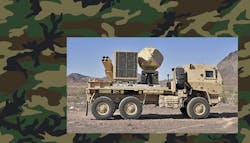Raytheon Delivers Counter-UAS to USAF
As a defense against the growing number of unmanned aerial systems (UASs) used for military applications, Raytheon delivered its first high-energy laser-based counter-UAS (C-UAS) to the U.S. Air Force earlier this month. The C-UAS, integrated into a ground vehicle, features Raytheon’s multi-spectral targeting system (MTS) with electro-optical/infrared (EO/IR), laser designation, and laser illumination capabilities integrated within a single sensor package.
The system will be deployed overseas as part of a one-year-long USAF experiment to train operators and evaluate the system’s effectiveness under real-world operating conditions. The company’s MTS line of sensors have logged nearly four million flight hours around the world in support of U.S. military, civilian, and allied missions. Once a threat drone has been targeted, the powerful C-UAS can neutralize it in seconds.
“Five years ago, few people worried about the drone threat,” said Roy Azevedo, president of Raytheon Space and Airborne Systems. “Now, we hear about attacks or incursions all the time. Our customers saw this coming and asked us to develop a ready-now counter-UAS capability. We did just that by going from the drawing board to delivery in less than 24 months.”
The high-energy laser weapon system was installed on a small all-terrain vehicle where it can provide intelligence, surveillance, reconnaissance, and dozens of laser shots running on a single charge from a 220-V outlet. It can provide more extended operation when working with a generator.
About the Author
Jack Browne
Technical Contributor
Jack Browne, Technical Contributor, has worked in technical publishing for over 30 years. He managed the content and production of three technical journals while at the American Institute of Physics, including Medical Physics and the Journal of Vacuum Science & Technology. He has been a Publisher and Editor for Penton Media, started the firm’s Wireless Symposium & Exhibition trade show in 1993, and currently serves as Technical Contributor for that company's Microwaves & RF magazine. Browne, who holds a BS in Mathematics from City College of New York and BA degrees in English and Philosophy from Fordham University, is a member of the IEEE.

